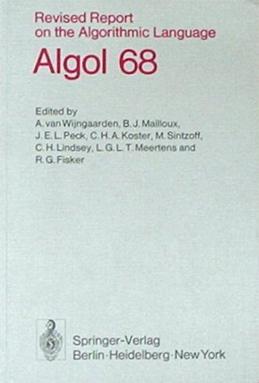Pascal is an imperative and procedural programming language, designed by Niklaus Wirth as a small, efficient language intended to encourage good programming practices using structured programming and data structuring. It is named after French mathematician, philosopher and physicist Blaise Pascal.
SAIL, the Stanford Artificial Intelligence Language, was developed by Dan Swinehart and Bob Sproull of the Stanford AI Lab. It was originally a large ALGOL 60-like language for the PDP-10 and DECSYSTEM-20. The language combined the earlier PDP-6/-10 language GOGOL compiler, essentially an integer-only version of ALGOL, with the associative store from the LEAP language. The first release was in November 1969 and it saw continued development into the 1980s, including a commercial derivative, MAINSAIL.
PL/0 is a programming language, intended as an educational programming language, that is similar to but much simpler than Pascal, a general-purpose programming language. It serves as an example of how to construct a compiler. It was originally introduced in the book, Algorithms + Data Structures = Programs, by Niklaus Wirth in 1976. It features quite limited language constructs: there are no real numbers, very few basic arithmetic operations and no control-flow constructs other than "if" and "while" blocks. While these limitations make writing real applications in this language impractical, it helps the compiler remain compact and simple.

ALGOL 68 is an imperative programming language that was conceived as a successor to the ALGOL 60 programming language, designed with the goal of a much wider scope of application and more rigorously defined syntax and semantics.

Per Brinch Hansen was a Danish-American computer scientist known for his work in operating systems, concurrent programming and parallel and distributed computing.
The computer programming languages C and Pascal have similar times of origin, influences, and purposes. Both were used to design their own compilers early in their lifetimes. The original Pascal definition appeared in 1969 and a first compiler in 1970. The first version of C appeared in 1972.
In computer programming, a one-pass compiler is a compiler that passes through the parts of each compilation unit only once, immediately translating each part into its final machine code. This is in contrast to a multi-pass compiler which converts the program into one or more intermediate representations in steps between source code and machine code, and which reprocesses the entire compilation unit in each sequential pass.
IP Pascal is an implementation of the Pascal programming language using the IP portability platform, a multiple machine, operating system and language implementation system. It implements the language "Pascaline", and has passed the Pascal Validation Suite.
In computer science, future, promise, delay, and deferred refer to constructs used for synchronizing program execution in some concurrent programming languages. They describe an object that acts as a proxy for a result that is initially unknown, usually because the computation of its value is not yet complete.
Concurrent computing is a form of computing in which several computations are executed concurrently—during overlapping time periods—instead of sequentially—with one completing before the next starts.

In computer science, recursion is a method of solving a computational problem where the solution depends on solutions to smaller instances of the same problem. Recursion solves such recursive problems by using functions that call themselves from within their own code. The approach can be applied to many types of problems, and recursion is one of the central ideas of computer science.
The power of recursion evidently lies in the possibility of defining an infinite set of objects by a finite statement. In the same manner, an infinite number of computations can be described by a finite recursive program, even if this program contains no explicit repetitions.
S-algol is a computer programming language derivative of ALGOL 60 developed at the University of St Andrews in 1979 by Ron Morrison and Tony Davie. The language is a modification of ALGOL to contain orthogonal data types that Morrison created for his PhD thesis. Morrison would go on to become professor at the university and head of the department of computer science. The S-algol language was used for teaching at the university at an undergraduate level until 1999. It was also the language taught for several years in the 1980s at a local school in St. Andrews, Madras College. The computer science text Recursive Descent Compiling describes a recursive descent compiler for S-algol, implemented in S-algol.
PLANC is a high-level programming language.
In computing, the producer-consumer problem is a family of problems described by Edsger W. Dijkstra since 1965.
Concurrent Pascal is a programming language designed by Per Brinch Hansen for writing concurrent computing programs such as operating systems and real-time computing monitoring systems on shared memory computers.
Joyce is a secure programming language for concurrent computing designed by Per Brinch Hansen in the 1980s. It is based on the sequential language Pascal and the principles of communicating sequential processes (CSP). It was created to address the shortcomings of CSP to be applied as a programming language, and to provide a tool, mainly for teaching, for distributed computing system implementation.
Pic Micro Pascala.k.a. PMP is a free Pascal cross compiler for PIC microcontrollers. It is intended to work with the Microchip Technology MPLAB suite installed; it has its own IDE (Scintilla-based) and it is a highly optimized compiler.
Ateji PX is an object-oriented programming language extension for Java. It is intended to facilliate parallel computing on multi-core processors, GPU, Grid and Cloud.

Parallel Specification and Implementation Language (ParaSail) is an object-oriented parallel programming language. Its design and ongoing implementation is described in a blog and on its official website.
Smart Pascal is a dialect of the Object Pascal programming language that is derived from Delphi Web Script, but is adapted for Smart Mobile Studio, a commercial development suite that generates JavaScript rather than machine code.



